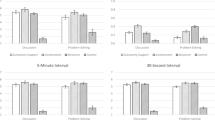Abstract
Children's perceptions of positive and negative parental behaviors were assessed using a newly-developed scale, the Parent Perception Inventory (PPI). Reliability and validity were examined across a sample of 75 children aged 5 to 13 using additional measures administered to the children and measures completed by their parents. The scale showed acceptable levels of internal consistency. No effects of children's age were apparent, but effects of the child's and parent's gender were found. Boys reported more positive parental behaviors, particularly for fathers, and children reported more negative (disciplinary) behaviors by mothers. PPI scores were predictably related to child's self-concept and behavior problems (convergent validity) and generally unrelated to measures of child's achievement (discriminant validity). As predicted by family systems theory, children from nondistressed families viewed their parents as behaving more similarly on the PPI than did children from distressed families.
Similar content being viewed by others
Reference notes
Christensen, A., & Margolin, G. Correlational and sequential analysis of the relationship between marital and child problems. Paper presented at the American Psychological Association, Los Angeles, 1981.
McDaniel, E. & Piers, E. A longitudinal study of elementary school effects: Design, instruments and specifications for a field test. Final report, Purdue Educational Research Center, Purdue University, 1973.
Hazzard, A., & Christensen, A. Parent Perception Inventory. Available from Andrew Christensen, Department of Psychology, University of California, Los Angeles, California, 90024.
Christensen, A., Phillips, S., Glasgow, R. E., & Johnson, S. M. Marital disturbance, parental psychopathology, parental cognitions, and interactional dysfunction in families with child behavior problems. Manuscript submitted for publication. (Available from Andrew Christensen, Department of Psychology, University of California, Los Angeles, California 90024).
References
Achenbach, T. M. The Child Behavior Profile: I. Boys Ages 6–11.Journal of Consulting and Clinical Psychology, 1978,46, 478–488.
Achenbach, T. M., & Edelbrock, C. S. The Child Behavior Profile: II. Boys ages 12–16 and girls ages 6–11 and 12–16.Journal of Consulting and Clinical Psychology, 1979,47, 223–233.
Becker, W. C. The relationship of factors in parental ratings of self and each other to the behavior of kindergarten children as rated by mothers, fathers, and teachers.Journal of Consulting Psychology, 1960,24, 507–527.
Bronson, W., Katten, E. S., and Livson, N. Patterns of authority and affection in two generationsJournal of Psychology, 1960,58, 143–152.
Campbell, D. J. Recommendations for APA test standards regarding construct, trait, and discriminant validity.Americal psycology, 196015, 546–553.
Coopersmith, S.The antecedents of self-esteem. San Francisco: Freeman, 1967.
Cronbach, L. Coefficient alpha and the internal structure of tests.Psychometrika, 1951,16, 297–334.
Dubin, R., & Dubin, E. R. Children's social perceptions: A review of research.Child Development, 1965,36, 809–838.
Goldin, P. A review of children's reports of parent behaviors.Psychological Bulletin, 1969,71, 222–236.
Jastak, J., & Jastak, S.The Wide Range Achievement Test. Wilmington, Del.: Jastak Associates, 1978.
Margolin, G., & Patterson, G. R. Differential consequences provided by mothers and fathers for their sons and daughters.Developmental Psychology, 1975,11, 537–538.
Minuchin, S.Families and family therapy. Cambridge: Harvard University Press, 1974.
Patterson, G. R., & Fagot, B. I. Selective responsiveness to social reinforcers and deviant behavior in children.Psychological Record, 1967,17, 369–378.
Piers, E., & Harris, D. Age and other correlates of self-concept in children.Journal of Educational Psychology, 1964,55, 91–95.
Rogers, T. R., Forehand, R., & Griest, P. L. The conduct disordered child: An analysis of family problems.Clinical Psychology Review, 1981,1, 139–147.
Schafer, E. Children's reports of parental behavior: An inventory.Child Development, 1965,36, 413–424.
Siegelman, M. Evaluation of Bronfenbrenner's Questionnaire for children concerning parental behavior.Child Development, 1965,36, 163–174.
Author information
Authors and Affiliations
Additional information
This investigation was conducted as part of the University Family Studies Project, a research project directed by the second and third authors and funded by the National Institute of Mental Health (MH 32616).
Rights and permissions
About this article
Cite this article
Hazzard, A., Christensen, A. & Margolin, G. Children's perceptions of parental behaviors. J Abnorm Child Psychol 11, 49–59 (1983). https://doi.org/10.1007/BF00912177
Revised:
Issue Date:
DOI: https://doi.org/10.1007/BF00912177




